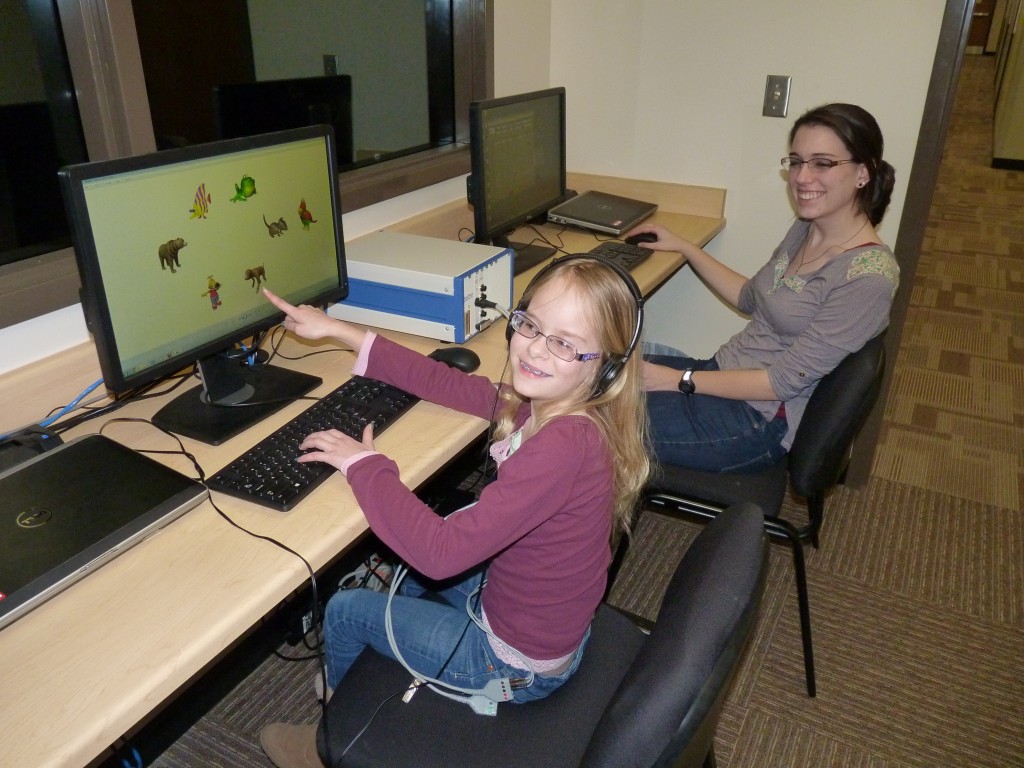Eye Tracking Studies
The High-Tech Lab at OSU Newark houses an Eye Link 1000 Plus remote eye tracker. This technology is safe and uses infrared cameras to track pupils/cornea reflections and records fixations and saccades every 2 ms! These studies provide important insights into the role of selective attention while children and adults are performing a variety of tasks such as learning new categories. All eye tracking studies are conducted in the High-Tech lab in 122 Founders Hall.

Eye Tracking Papers
Robinson, C.W., Barnhart, W, & Rivera, S. (under review). Auditory stimuli slow down responses and first fixations: Support for auditory dominance in adults. Proceedings of the Cognitive Science Society.
Best, C. A., Robinson, C. W., & Sloutsky, V. M. (under review). Developmental changes in the role of selective attention in category learning: Evidence from eye tracking. Developmental Psychology.
Best, C. A., Robinson, C. W., & Sloutsky, V. M. (2011). The effect of labels on categorization: Is attention to relevant features a good index of infants’ category learning? In L. Carlson, C. Hölscher, & T. Shipley (Eds.), Proceedings of the 33rd Annual Conference of the Cognitive Science Society (pp. 2751-2755). Austin, TX: Cognitive Science Society.
Best, C. A., Robinson, C. W., & Sloutsky, V. M. (2011). The effect of labels on children’s category learning. In L. Carlson, C. Hölscher, & T. Shipley (Eds.), Proceedings of the 33rd Annual Conference of the Cognitive Science Society (pp. 3332-3336). Austin, TX: Cognitive Science Society.
Best, C. A., Robinson, C. W., & Sloutsky, V. M. (2010). The effect of labels on visual attention: An eye tracking study. In S. Ohlsson & R. Catrambone (Eds.), Proceedings of the 32nd Annual Conference of the Cognitive Science Society (pp 1846-1851). Austin, TX: Cognitive Science Society.
Heart Rate Studies
In previous research we have used heart rate as a way to measure attention (e.g., heart rate slows down when young children are actively attending to auditory and visual information). We are also interested in Heart Rate Variability (i.e., HRV is a way to quantify individual differences in timing between heart beats), and we are currently testing if HRV can be used to predict how well children and adults pay attention. We use a BioNex acquisition unit with a BioNex Impedance Cardiograph and GSC amplifier to collect electrocardiograms and we time-lock these electrocardiograms with stimulus presentation so we can examine moment to moment changes in heart rate as children and adults are processing new information.
Heart Rate Papers/Presentations
Dunifon, C., & Robinson, C.W. (2015, May). Heart rate variability associated with attentional control in high-load flanker tasks. Poster presented at the Annual meeting of the Midwestern Psychological Association, Chicago, IL.
Robinson, C. W., Miser, T., Williams. D., Thayer, J. F., & Sloutsky, V. M. (2014, July). Heart Rate Variability as a Predictor of Infants’ Auditory and Visual Processing. Poster presented at the Biennial International Conference for Infant Studies, Berlin, Germany.
Robinson, C. W. & Sloutsky, V. M. (2012, June). Infants’ cardiac responses to changing auditory, visual, and cross-modal information. Poster presented at the Biennial International Conference for Infant Studies, Minneapolis, MN.
Robinson, C. W., & Sloutsky, V. M. (2010). Attention and cross-modal processing: Evidence from heart rate analyses. In S. Ohlsson & R. Catrambone (Eds.), Proceedings of the 32nd Annual Conference of the Cognitive Science Society (pp 2639-2643). Austin, TX: Cognitive Science Society.

